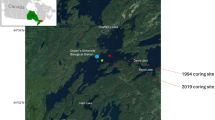Abstract
The Nilnag (alt. 2180 m) situated in the Kashmir Himalayas, marks the beginning of the dimictic lake series of this region. The high turbidity of water (ηt : % MathType!MTEF!2!1!+-% feaafiart1ev1aaatCvAUfeBSjuyZL2yd9gzLbvyNv2CaerbuLwBLn% hiov2DGi1BTfMBaeXatLxBI9gBaerbd9wDYLwzYbItLDharqqtubsr% 4rNCHbGeaGqiVu0Je9sqqrpepC0xbbL8F4rqqrFfpeea0xe9Lq-Jc9% vqaqpepm0xbba9pwe9Q8fs0-yqaqpepae9pg0FirpepeKkFr0xfr-x% fr-xb9adbaqaaeGaciGaaiaabeqaamaabaabaaGcbaGadiiEayaara% aaaa!3703!\[\bar x\] = 1.16) as a result of accelerated particle movement from the adjoining terrestrial ecosystem, has affected the sensitive macroflora which was recorded five decades ago. The lake water chemistry depicts a cation pattern which is dominated by divalent calcium (Ca++ > Mg++ > Na+ > K+) and the anions by a carbonate-bicarbonate system (HC′O3 > SO″4 > Cl′). The ionic composition of the lake water comes close to the World Standard for freshwater lakes. The levels of ortho-phosphate and nitrate-nitrogen are not very high, indicating ‘moderate fertility’ of the lake. The phytoplankton production, as measured by 14C isotope technique, ranged from 120–562 Σ mgCassim m−2 d−1 during the ice-free period (1975–76) with an annual estimated yield of 90–100 gC m−2. The vertical distribution of production is suggestive of plankton rich lake water. In its general limnological features, the Nilnag resembles mesotrophic lakes of the Kashmir valley.
Similar content being viewed by others
References
APHA-AWWA-WPCF. 1960. Standard methods for the examination of water, sewage and industrial wastes. Amer. Publ. Health Assoc. Inc; New york.
Blatter, E. 1927. Beautiful flowers of Kashmir. John Bala, Sons & Damelsson Ltd; London.
Copeland, H. J. & Dorris, T. C. 1964. Community metabolism in ecosystem receiving oil refinery affluents. Limnol. Oceanogr. 9: 431–447.
Findenegg, I. 1964. Types of planktonic primary production in the lakes of the Eastern Alps as found by the radio-active carbon method. Verh. Int. Ver. Limnol. 15: 352–359.
Freiser, H. & Fernando, Q. 1966. Ionic equilibria in analytical chemistry. Wiley & Sons; New York.
Hickel, B. 1973. Limnological investigations in lakes of the Pokhara Valley, Nepal. Int. Rev. ges. Hydrobiol. 58 (5): 659–672.
Hutchinson, G. E. 1937. Limnological studies in Indian Tibet. Int. Rev. Hydrobiol. 35: 134–177.
Hutchinson, G. E. 1957. A treatise on limnology. Vol. I. Geography, physics and chemistry. John Willey & Sons, Inc; New York & London.
Hutchinson, G. E. & Löffler, H. 1956. The thermal classification of lakes. Proc. Natl. Acad. Sci, U.S.A. 42: 84–86.
Jones, J. R. & Bachmann, R. W. 1974. Limnological features of some Northwestern Iowa lakes. Proc. Iowa. Acad. Sci. 81: 158–163.
Khan, M. A. & Zutshi D. P. 1980. Primary productivity and tropic status of Kashmir Himalayan lake. Hydrobiologia, 68: 3–8.
Löffler, H. 1969. High altitude lakes in Mt. Everest region. Verh. Int. Ver. Limnol. 17: 373–385.
Mackereth, F. J. H. 1963. Water analysis for limnologists. Freshwat. Biol. Assoc. 21: 1–70.
Odum, H. T. & Hoskin, G. M. 1957. Metabolism of a laboratory stream microcosm. Publs. Inst. mar. Sci. Univ. Tex. 4: 115–133.
Rodhe, W. 1949. The ionic composition of lake waters. Verh. Int. Ver. Limnol. 10: 377–386.
Rodhe, W. 1958. Primärproduktion und Seetypen. Verh. Int. Ver. Limnol. 13: 121–141.
Ryther, J. H. 1956. Photosynthesis in the ocean as a function of light intensity. Limnol. Oceanogr. I: 61–70.
Sawyer, C. N., Lackey, J. B. & Lenz, A. T. 1945. Investigation of the odour nuisances in the Madison lakes, particularly Lakes Manous, Wanbesa and Kegonsa from July 1943 to July 1944, Madison Univ., Press.
Steeman Nielsen, E. 1952. The use of radio-active carbon C-14 for measuring organic production in the sea. J. Cons. Int. Explor. Mer. 18: 117–140.
Vollenweider, R. A. & Nauwerck, A. 1961. Some observations on the 14C method for measuring primary production. Verh. Int. Ver. Limnol. 14: 134–139.
Welch, P. S. 1948. Limnological methods. McGraw-Hill Book Co, Ltd; New York.
Wetzel, R. G. & Otsuki, A. 1974. Allochthonous organic carbon of a marl lake. Arch. Hydrobiol. 73: 31–56.
Zutshi, D. P., Kaul, V. & Vass, K. K. 1972. Limnology of high altitude Kashmir lakes. Verh. Int. Ver. Limnol. 18: 599–604.
Zutshi, D. P. & Khan, M. A. 1977. Limnological investigations of two sub-tropical lakes. Geobios. 4 (2): 45–48.
Zutshi, D. P. & Khan, M. A. 1978. On lake typology of Kashmir. Environ. Physiol. Ecol. Plants. 465–472.
Author information
Authors and Affiliations
Additional information
Formed a part of thesis for which Ph.D. was awarded to MAK by Kashmir University
Formed a part of thesis for which Ph.D. was awarded to MAK by Kashmir University
Rights and permissions
About this article
Cite this article
Khan, M.A., Zutshi, D.P. Contribution to high altitude limnology of the Himalayan system I. Limnology and primary productivity of the plankton community of Nilnag Lake, Kashmir. Hydrobiologia 75, 103–112 (1980). https://doi.org/10.1007/BF00007422
Received:
Published:
Issue Date:
DOI: https://doi.org/10.1007/BF00007422




